назад
Лаборатория «Математическое моделирование геофизических процессов»
Сотрудники лаборатории
Шувалов Валерий Викторович д.ф.-м.н.
заведующий лабораторией

Артемьева Наталия Анатольевна к.ф.-м.н.
старший научный сотрудник

Попова Ольга Петровна к.ф.-м.н.
старший научный сотрудник

Светцов Владимир Владимирович д.ф.-м.н.
ведущий научный сотрудник

Хазинс Валерий Михайлович к.ф.-м.н.
ведущий научный сотрудник
Зав. лабораторией, д.ф.-м.н. В.В. Шувалов
Основное направление исследований:
Природные катастрофы в условиях высокотехнологичного общества. Развитие методов моделирования природных катастрофических явлений и изучение последствий конкретных природных явлений (в том числе фреатомагматических вулканических извержений и ударов космических тел разного размера) методами численного эксперимента.
Текущие задачи:
-
Изучение процесса и последствий возможных столкновений Земли с космическими телами размером в несколько сотен метров. Построение физико-математических моделей подобных катастроф, оценка их влияния на окружающую среду и роли в эволюции планеты Земля.
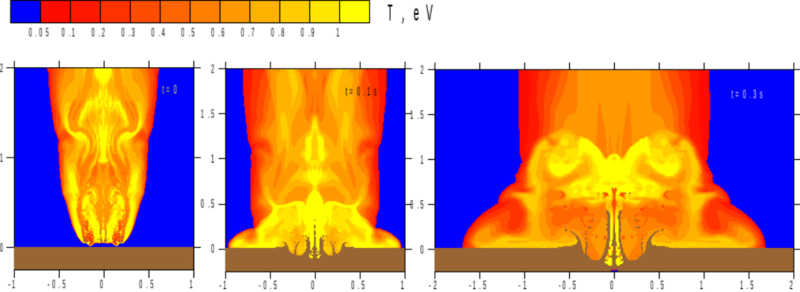
Результаты моделирования удара разрушенного стометрового каменного тела по поверхности Земли. Расстояния указаны в километрах.
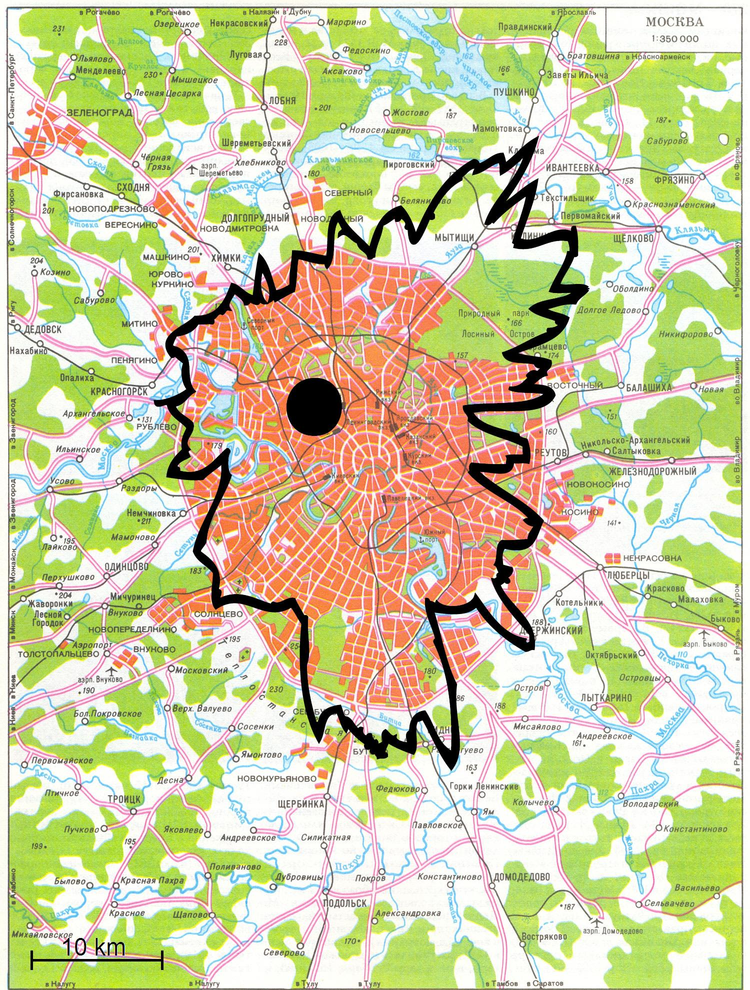
Сопоставление области вывала леса на месте взрыва Тунгусского космического тела (астероида размером 50-100 м) с территорией современной Москвы. Возможная площадь разрушения, вызванная ударными волнами в атмосфере, превышает 2000 км2.
- Разработка физико-математических моделей извержения вулканов, покрытых льдом и оценка воздействия таких извержений на окружающую среду.

Моделирование эруптивной колонки фреатомагматического извержения. Периодическое всплытие газо-пепловых пузырей из кратера вулкана. Радиус пузырей 400 м, период - 3 мин. Фрагмент (а1)соответствует моменту времени 3 мин, (а2) - 30 мин, (а3) - 1 часу.
- Построение модели инициирования и динамики надоблачных разрядов, учитывающих сложную структуру грозового облака и совмещающих достаточно полную плазмохимическую картину процессов в средней атмосфере с процессами распространения электромагнитного импульса молний в магнитном поле
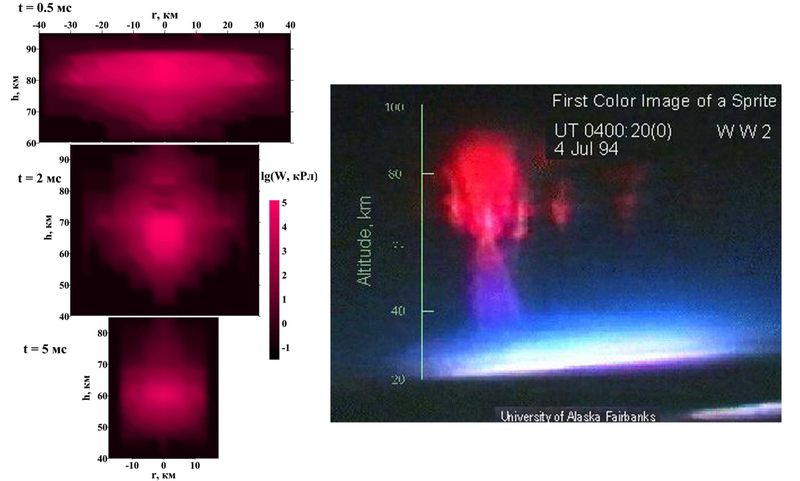
Пространственные распределения интенсивности W 1-ой положительной полосы молекулы азота в различные моменты времени в процессе распространения высотного разряда.
- Расчет величин и конфигураций электрических и магнитных полей при различных возможных механизмах генерации токов в разломах при их подвижках в процессе сильного землетрясений.

На рисунке представлены распределения вертикальной компоненты электрического поля EH в процессе сильного землетрясения 1995 г. в г.Кобе (Япония) на горизонтальной поверхности раздела воздух/грунт(вода). Эпицентр землетрясения обозначен звездочкой.
- Изучение процессов, происходящих при взаимодействии метеороидов (размерами от микрон до метров) с атмосферой Земли. Построение физико-математических моделей взаимодействия, оценка влияния постоянного притока космического вещества на окружающую среду.
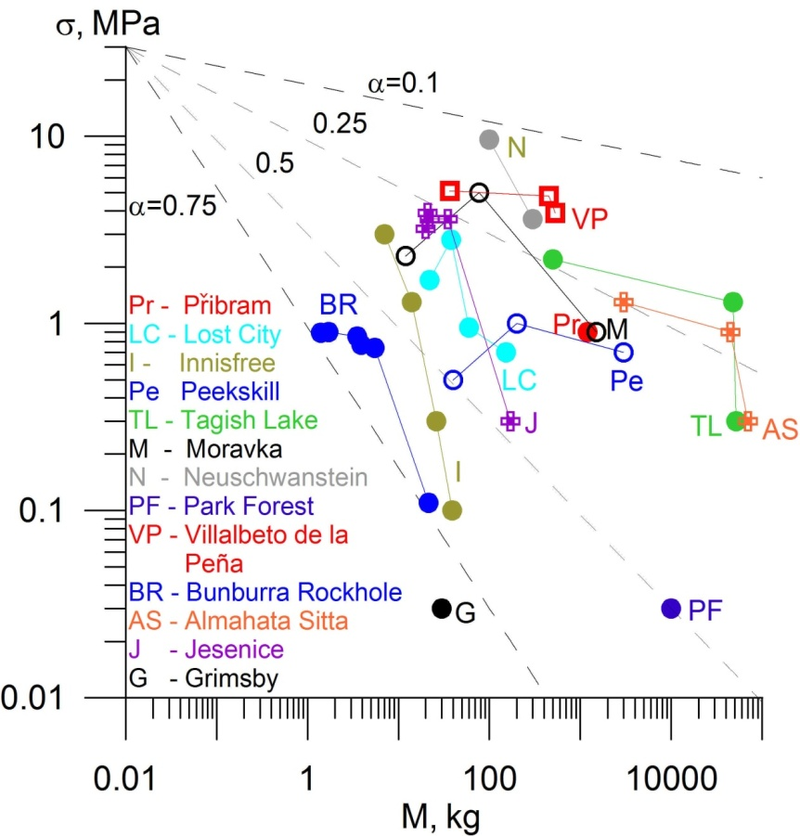
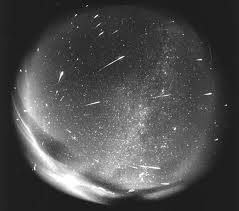
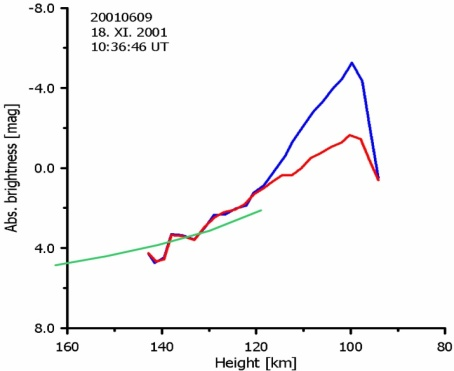
Оценка прочности метеороидов, вход в атмосферу которых был инструментально зарегистрирован, и найдены метеориты. Метеоры потока Леониды 1998 (Modra observatory); Сравнение излучения, возникающего за счет распыления поверхности метеороида (модель) с наблюдениями на больших высотах (120-150 км.
ПУБЛИКАЦИИ в рецензируемых журналах, 2010-2012 гг.
-
Лосева Т.В., М.Ю. Кузьмичева, А.А.Спивак. 2010. Электрические и магнитные сигналы при стесненных движениях блоков земной коры // ДАН, том 432, № 5, с. 685-688. C2 0.269.
Предложена модель генерации электрических и магнитных импульсов в земной коре при электрической поляризации горных пород с низким водосодержанием в результате квазинезависимого поворота структурного блока при его релаксации в стесненных условиях в качестве источника электрических и магнитных импульсов. В результате быстропротекающего стесненного поворота релаксирующего блока формируется дифференциальное смещение на контакте его активной грани с окружающими горными породами, что вызывает электрическую поляризацию вещества-заполнителя межблокового промежутка в результате преобразования его структуры и физико-механических свойств. Сформировавшаяся при этом система токов имеет импульсный характер и является источником электрических и магнитных импульсов, которые распространяются в пространстве. Приведены результаты численного 3D моделирования процесса генерации электрических и магнитных импульсов при дифференциальной подвижке активного структурного блока земной коры.
-
Т.В. Лосева, А.А.Спивак, М.Ю. Кузьмичева Дипольная модель генерации электрических импульсов при релаксационных процессах в земной коре // ДАН, 2012, том. 442. № 3. С. 401-404.
Разработана дипольная модель генерации электрических и магнитных импульсов в земной коре при электрической поляризации горных пород с низким водосодержанием в результате квазинезависимого поворота структурного блока при его релаксации в стесненных условиях. Электрические моменты диполей изменяются со временем в соответствии с амплитудой дифференциальных движений. Проведено численное 3D моделирование электродинамических процессов при различной ориентации блоков. Показано, что амплитуда электрического и магнитного импульсов, возникающих в окрестности активной грани деформирующегося блока, хорошо согласуется с результатами регистрации электрического поля в приповерхностном слое земной коры в зоне влияния тектонически активной Курайской структуры (Горный Алтай). Модель позволяет проводить сравнение разных участков земной коры по относительной величине параметров механического источника путем сравнения расчетных и экспериментальных данных.
-
В.В. Шувалов, И.А. Трубецкая. 2010. Влияние внутреннего трения на деформацию разрушенного метеороида // Астрономический Вестник, т .44, № 2, с. 117-122.
Показано, что учет влияния внутреннего трения на деформацию разрушенного метеороида приводит к заметному (на 10–20 км) уменьшению высоты его торможения и, соответственно, высоты, на которой выделяется энергия. Обсуждается возможное уменьшения роли внутреннего трения за счет“акустической флюидизации” и проникновения ударно_сжатого газа через трещины внутрь разрушенного метеороида.
-
Шувалов В.В., Н.А. Артемьева, М.Ю. Кузьмичева, Т.В. Лосева, В.В. Светцов, В.М. Хазинс. Выбросы из кратеров - маркеры ударных катастроф // Физика Земли, 2012. Т. 48, № 3, с. 241-255.
В статье рассматривается роль выбросов из ударных кратеров в эволюции Земли и планет Солнечной системы. Методами численного моделирования исследуются аккреция и эрозия планет, перераспределение планетного вещества в результате ударов крупных космических тел и вызываемые ими межгеосферные взаимодействия, несимметричность распределение выбросов вблизи кратерного вала и возможность небаллистического переноса выбросов. Проводится сравнение воздействия на геосферы ударных событий и вулканических извержений.
-
Хазинс В.М. 2010. Метод крупных вихрей в задачах всплытия высокотемпературных термиков в стратифицированной атмосфере // ТВТ, 48, № 3, с. 424-432.
Для задач всплытия высокотемпературного термика численно исследуются характерные особенности газодинамического потока при моделировании турбулентного перемешивания методом крупных вихрей. Продемонстрировано хорошее согласие динамики всплытия верхней кромки нагретого облака с экспериментальными и теоретическими данными при значении параметра метода (константы Смагоринского) порядка единицы, в то время как наиболее часто используются значения 0.1−0.2. Расчеты всплытия бесконечной системы регулярно расположенных у поверхности Земли термиков на достаточно подробных сетках позволили уточнить некоторые рассчитанные ранее характеристики подъема такой системы.
-
Хазинс В.М. Моделирование медленных турбулентных течений в атмосфере, инициированных литосферными источниками возмущений // Физика Земли, 2012. 48, № 3, с. 93–100.
Приводятся результаты численных экспериментов, выполненных с помощью упрощенной нестационарной модели турбулентного потока вязкого сжимаемого газа для двух классов течений, масштаб которых сравним с высотой тропосферы. В одном из них (на примере метана) исследована возможность достижения легкими газами тропопаузы при их интенсивном выделении из литосферы и определены необходимые для этого объемы. Во втором случае исследовано взаимодействие ветрового потока с орографическими неоднородностями и продемонстрировано развитие интенсивного вихревого процесса.
-
Artemieva N. and Pierazzo E. 2011. The Canyon Diablo impact event: 2. Projectile fate and target melting upon impact // M&PS 46, 805-829.
Despite its centennial exploration history, there are still unresolved questions about Meteor Crater, the first recognized impact crater on Earth. This theoretical study addresses some of these questions by comparing model results with field and laboratory studies of Meteor Crater. Our results indicate that Meteor Crater was formed by a high-velocity impact of a fragmented projectile, ruling out a highly dispersed swarm as well as a very low impact velocity. Projectile fragmentation caused many fragments to fall separately from the main body of the impactor, making up the bulk of the Canyon Diablo meteorites; most of these fragments were engulfed in the expansion plume as they approached the surface without suffering high shock compression, and were redistributed randomly around the crater. Thus, the distribution of Canyon Diablo meteorites is not representative of projectile trajectory, as is usual for impactor fragments in smaller strewn fields. At least 50% of the main impactor was ejected from the crater during crater excavation and was dispersed mostly downrange of the crater as molten particles (spheroids) and highly shocked solid fragments (shrapnel). When compared with the known distribution, model results suggest an impactor from the SW. Overall, every model case produced much higher amounts of pure projectile material than observed. The projectile-target mixing was not considered in the models; however, this process could be the main sink of projectile melt, as all analyzed melt particles have high concentrations of projectile material. The fate of the solid projectile fragments is still not completely resolved. Model results suggest that the depth of melting in the target can reach the Coconino sandstone formation. However, most of the ejected melt originates from 30-40 m depth and, thus, is limited to Moenkopi and upper Kaibab material. Some melt remains in the target; based on the estimated volume of the breccia lens at Meteor Crater, our models suggest at most a 2% content of melt in the breccia. Finally, a high water table at the time of impact could have aided strong dispersion of target and projectile melt.
-
Grieve R.A.R., Ames D.E., Morgan J.V., Artemieva N. 2010. The evolution of the Onaping formation at the Sudbury impact structure // Meteoritics and Planetary Science 45, 759-782.
The 1.4-1.6km thick Onaping Formation consists of a complex series of breccias and ``melt bodies'' lying above the Sudbury Igneous Complex (SIC) at the Sudbury impact structure. Based on the presence of shocked lithic clasts and various ``glassy'' phases, the Onaping has been described as a ``suevitic'' breccia, with an origin, at least in part, as fallback material. Recent mapping and a redefined stratigraphy have emphasized similarities and differences in its various vitric phases, both as clast types and discrete intrusive bodies. The nature of the Onaping and that of other ``suevitic'' breccias overlying impact melt sheets is reviewed. The relative thickness, internal stratigraphic and lithological character, and the relative chronology of depositional units indicate multiple processes were involved over some time in the formation of the Onaping. The Sudbury structure formed in a foreland basin and water played an essential role in the evolution of the Onaping, as indicated by a major hydrothermal system generated during its formation. Taken together, observations and interpretations of the Onaping suggest a working hypothesis for the origin of the Onaping that includes not only impact but also the interaction of sea water with the impact melt, resulting in repeated explosive interactions involving proto-SIC materials and mixing with pre-existing lithologies. This is complicated by additional brecciation events due to the intrusion of proto-SIC materials into the evolving and thickening Onaping. Fragmentation mechanisms changed as the system evolved and involved vesiculation in the formation of the upper two-thirds of the Onaping.
-
Hartmann W.K., Quantin C., Werner S.C., Popova O. 2010. Do young martian ray craters have ages consistent with the crater count system? // Icarus 208 (2), 621-635.
McEwen et al. (McEwen, A.S., Preblich, B.S., Turtle, E.P., Artemieva, N.A., Golombek, M.P., Hurst, M., Kirk, R.L., Burr, D.M., Christensen, P. [2005]. Icarus 176, 351–381) developed a useful test for the internal consistency of crater-count chronometry systems. They argued that certain multi-kilometer, fresh-looking martian craters with prominent rays should be the youngest or near-youngest craters in their size range. The ‘‘McEwen et al. test” is that the ages determined from crater densities of the smallest superimposed craters (typically diameter D _ 5–20 m) should thus be comparable to the expected formation intervals of the host primary. McEwen et al. concluded from MOC data that crater chronometry failed this test by factors of 700–2000. We apply HiRISE and other imagery to eight different young craters in order to re-evaluate their arguments. We use existing crater chronology systems as well as the reported observed production rate of 16 m craters (Malin, M.C., Edgett, K., Posiolova, L., McColley, S., Noe Dobrea, E. [2006]. Science 314, 1573–1557; Hartmann, W.K., Quantin, C., Mangold, N. [2007]. Icarus 186, 11–23; Kreslavsky[2007]. Seventh International Conference on Mars, 3325). Every case passes the McEwen et al. test. We conclude that the huge inconsistencies suggested by McEwen et al. are spurious. Many of these craters show evidence of impact into ice-rich material, and appear to have ice-flow features and sublimation pits on their floors. As production rate data improve, decameter-scale craters will provide a valuable way of dating these young martian geological formations and the processes that modify them.
-
Losseva T.V., S.I. Popel, A.P. Golub’, Yu.N. Izvekova, and P.K. Shukla Weakly dissipative dust-ion-acoustic solitons in complex plasmas and the effect of electromagnetic radiation // Phys.Plasmas. 2012. V.19. No 1. P. 013703.
Possibility for dust ion-acoustic solitons to exist in complex (dusty) plasmas in the presence of electromagnetic radiation, which results in positive dust particle charges, is investigated. Dissipative processes occurring during the propagation of dust ion-acoustic perturbations, among which are the charging of dust grains, the absorption of ions by grains, the transfer of the ion momentum to the grains, and ion-neutral collisions, are taken into account. Temporal evolution of the soliton-like perturbation and interaction of two soliton-like perturbations are studied. Compressive soliton-like perturbations are shown to possess the main properties of the soltons, in particular, the interacting perturbations conserve their form.
-
Mann I., Pellinen-Wannberg A., Murad E., Popova O., Meyer-Vernet N., Rosenberg M., Mukai T., Czechowski A., Mukai S., Safrankova J., Nemecek Z. 2011. Dusty Plasma Effects in Near Earth Space and Interplanetary Medium // Space Science Reviews 161, 1-47.
We review dust and meteoroid fluxes and their dusty plasma effects in the interplanetary medium near Earth orbit and in the Earth’s ionosphere. Aside from in-situ measurements from sounding rockets and spacecraft, experimental data cover radar and optical observations of meteors. Dust plasma interactions in the interplanetary medium are observed by the detection of charged dust particles, by the detection of dust that is accelerated in thesolar wind and by the detection of ions and neutrals that are released from the dust. These interactions are not well understood and lack quantitative description. There is still a huge discrepancy in the estimates of meteoroid mass deposition into the atmosphere. The radar meteor observations are of particular interest for determining this number. Dust measurements from spacecraft require a better understanding of the dust impact ionization process, as well as of the dust charging processes. The latter are also important for further studying nanodust trajectories in the solar wind. Moreover understanding of the complex dependencies that cause the variation of nanodust fluxes is still a challenge.
-
Meyer C., Fritz J., Misgaiski M., Stöffler D., Artemieva N., Hornemann U., Möller R., de Vera J.-P., Cockell C., Horneck G., Ott S., Rabbow E. 2011. Shock experiments in support of the Lithopanspermia theory. The influence of host rock composition, temperature, and shock pressure on the survival rate of endolithic and epilithic microorganisms // Meteoritics and Planetary Science 46, 701-718.
Shock recovery experiments were performed with an explosive set-up in which three types of microorganisms embedded in various types of host rocks were exposed to strong shock waves with pressure pulse lengths of lower than 0.5 μs: spores of the bacterium Bacillus subtilis, Xanthoria elegans lichens, and cells of the cyanobacterium Chroococcidiopsis sp. 029. In these experiments, three fundamental parameters were systematically varied (1) shock pressures ranging from 5 to 50 GPa, (2) preshock ambient temperature of 293, 233 and 193 K, and (3) the type of host rock, including nonporous igneous rocks (gabbro and dunite as analogs for the Martian shergottites and chassignites, respectively), porous sandstone, rock salt (halite), and a clay-rich mineral mixture as porous analogs for dry and water-saturated Martian regolith. The results show that the three parameters have a strong influence on the survival rates of the microorganisms. The most favorable conditions for the impact ejection from Mars for microorganisms would be (1) low porosity host rocks, (2) pressures <10-20 GPa, and (3) low ambient temperature of target rocks during impact. All tested microorganisms were capable of surviving to a certain extent impact ejection in different geological materials under distinct conditions.
-
Pierazzo E., Artemieva N. 2012. Local and Global Environmental Effects of Impacts on Earth // Elements, 8, 55-60.
The environmental effects of impact events differ with respect to time (seconds to decades) and spatial (local to global) scales. Short-term localized damage is produced by thermal radiation, blast-wave propagation in the atmosphere, crater excavation, earthquakes, and tsunami. Global and long-term effects are related to the ejection of dust and climate-active gases (carbon dioxide, sulfur oxides, water vapor, methane) into the atmosphere. At the end of the Cretaceous, the impact of a >10 km diameter asteroid led to a major mass extinction. Modern civilization is vulnerable to even relatively small impacts, which may occur in the near future, that is, tens to hundreds of years.
-
Popova O.P., Borovi
-
ka J., Hartmann W.K., Spurný P., Gnos E., Nemtchinov I., Trigo-Rodríguez J.M. 2011. Very low strengths of interplanetary meteoroids and small asteroids // Meteoritics & Planetary Science 46 (10), 1525-1550.
We have assembled data on 13 cases of meteorite falls with accurate tracking data on atmospheric passage. In all cases, we estimate the bulk strength of the object corresponding to its earliest observed or inferred fragmentation in the high atmosphere, and can compare these values with measured strengths of meteorites in the taxonomic class for that fall. In all 13 cases, the strength corresponding to earliest observed or inferred fragmentation is much less than the compressive or tensile strength reported for that class of stony meteorites. Bulk strengths upon atmospheric entry of these bodies are shown to be very low, 0.1 to approximately 1 MPa on first breakup, and maximal strength on breakup as 1–10 MPa corresponding to weak and ‘‘crumbly’’ objects, whereas measured average tensile strength of the similar meteorite classes is about 30 MPa. We find a more random relation between bulk sample strength and sample mass than is suggested by a commonly used empirical power law.We estimate bulk strengths on entry being characteristically of the order of 10-1–10-2 times the tensile strengths of recovered samples. We conclude that pre-entry, meter-scale interplanetary meteoroids are typically highly fractured or in some cases rubbly in texture, presumably as a result of their parent bodies’ collisional history, and can break up under stresses of a few megapascals. The weakness of some carbonaceous objects may result from very porous primordial accretional structures, more than fractures. These conclusions have implications for future asteroid missions, sample extraction, and asteroid hazard mitigation.
-
Shuvalov V. 2011. Ejecta deposition after oblique impacts: An influence of impact scale // Meteoritics and Planetary Science 46, 1713-1718.
Simple estimates suggest that ejecta blankets around larger craters should be more asymmetric than around smaller craters for the same oblique impact angle. Numerical simulations presented in the paper confirm that an increase in the scale of gravity-dominated craters (and in the size of the corresponding projectiles) increases the asymmetry of both impact craters and ejecta blankets around them.
-
Shuvalov V. 2012. A mechanism for the production of crater rays // Meteoritics and Planetary Science 47, 262-267.
A mechanism for the production of crater rays is proposed that is based on the interaction of impact-induced shock waves with existing (old) craters. Numerical simulations are used to test this idea, and to study the influence of inherited craters' size and location on the rays' parameters. The results of the simulations show that crater rays (at least, some of them) could be produced through this mechanism.
-
Shuvalov Valery, Henning Dypvik, Filippos Tsikalas. 2010. The Impact Dynamics. In The Mjolnir Impact Event: Geology and Geophysics of a Lake Jurassic/Early Cretaceous Submarine Impact Structure. Edited by Henning Dypvik, Filippos Tsikalas, Morten Smelror. Heidelberg: Springer, Chapter 7, 195-210. Hardcover ISBN: 978-3-540-88259-6.
Crater-ejecta correlation is an important element in the analysis of crater formation and its influence on the geological evolution. In this study, both the ejecta distribution and the internal crater development of the Jurassic/Cretaceous Mjølnir Crater (40 km in diameter; located in the Barents Sea) are investigated through numerical simulations. The simulations show a highly asymmetrical ejecta distribution and underscore the importance of a layer of surface water in ejecta distribution. As expected, the ejecta asymmetry increases as the angle of impact decreases. The simulation also displays an uneven aereal distribution of ejecta. The generation of the central high is a crucial part of crater formation. In this study, peak generation is shown to have a skewed development, from approximately 50 s to 90 s after impact, when the peak reaches its maximum height of 1 to 1.5 km. During this stage, the peak crest is moved about 5 km from an uprange to a downrange position, ending with a final central position which has a symmetrical appearance that contrasts with its asymmetrical development.
-
Shuvalov V., Dypvik, Henning, Kalleson Elin,Setså Ronny, Riis Fridtjof. 2012. Modeling the 2.7 km in Diameter, Shallow Marine Ritland Impact Structure // Earth, Moon, and Planets, Online First.
The newly discovered Ritland impact structure (2.7 km in diameter) has been modeled by numerical simulation, based on detailed field information input. The numerical model applies the SOVA multi-material hydrocode, which uses the ANEOS equation of state for granite, describing thermodynamical properties of target and projectile material. The model displays crater formation and possible ejecta distribution that strongly supports a 100 m or less water depth at the time of impact. According to the simulations resurge processes and basinal syn- and postimpact sedimentation are highly dependent on water depth; in more than 100 m of water depth, much more powerful resurge processes are generated than at water depths shallower than 100 m (the Ritland case). In Ritland the 100 m high (modeled) crater rim formed a barrier and severely reduced the resurge processes. In the case of deeper water, powerful resurge processes, tsunami wave generations and related currents could have triggered even more violent crater fill sedimentation. The presented model demonstrates the importance of understanding the interactions between water layer and both syn-impact crater fill and ejecta distribution. According to the presented simulations ejecta blocks up to 10 m in diameter could be transported up to about 5 km outside the crater rim.

